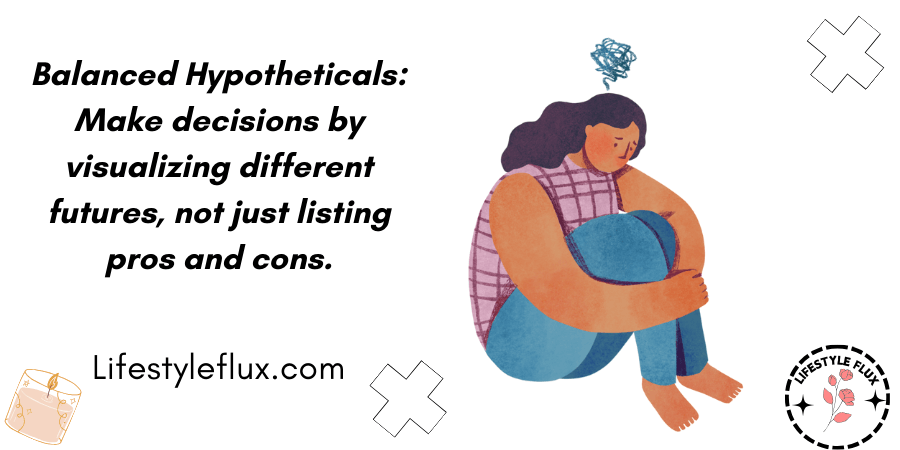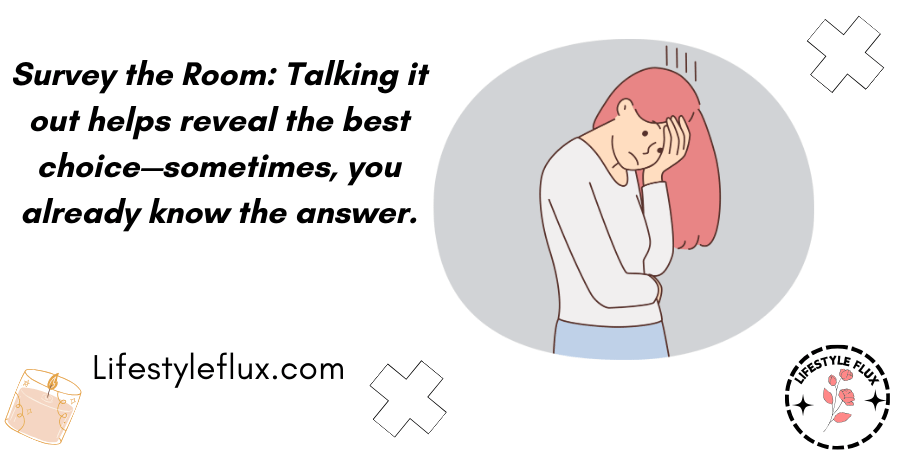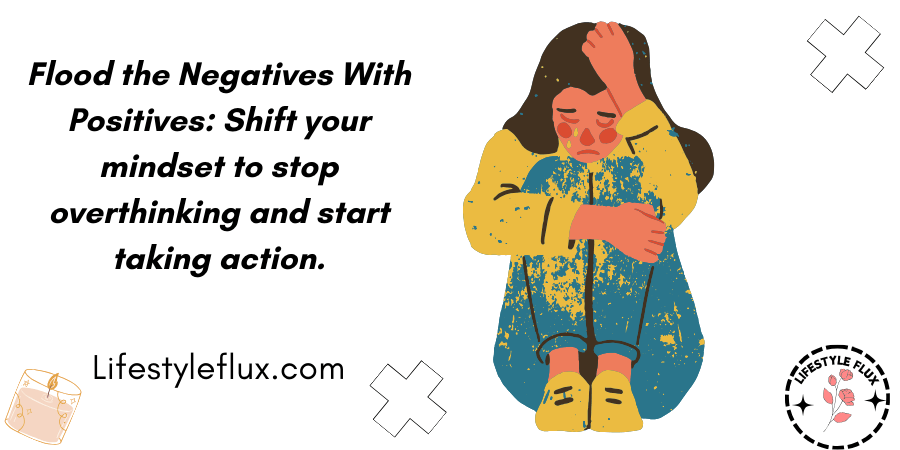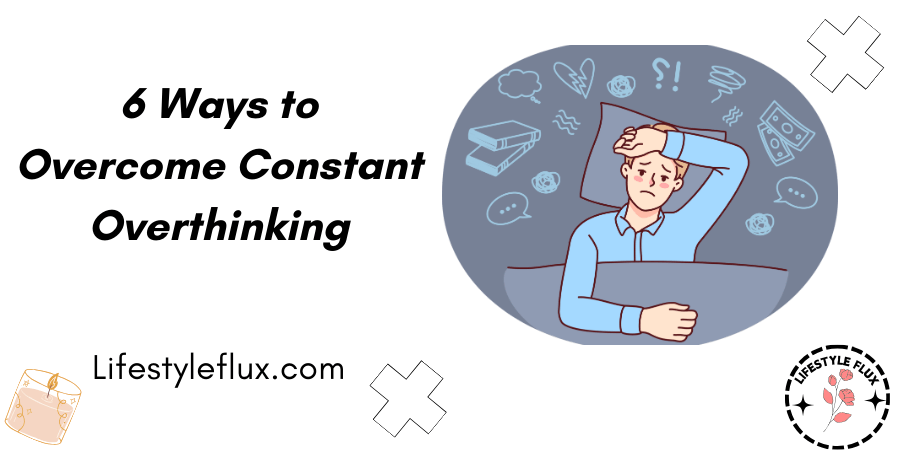Overthinking can feel like a never-ending maze, where every turn leads to more questions and fewer answers. If you’ve ever found yourself stuck in a loop of “what ifs” and “buts,” you’re not alone.
The constant analysis of every possible outcome can be exhausting, leaving you paralyzed and unable to move forward.
In this article, 6 Ways to Overcome Constant Overthinking, we’ll explore practical strategies to break free from this mental trap.
From balancing hypotheticals to trusting your gut, these methods will help you regain clarity, make confident decisions, and reclaim your peace of mind.
Table of Contents
1. Balanced Hypotheticals
How can you be decisive when you’re facing a huge life-altering decision? Well, imagine deciding whether or not to go back to school. It could open all kinds of new doors for your career.
You could make helpful connections you could learn about new avenues to explore within your field. But on the other hand, you’d be sacrificing a ton of your time and a whole lot of money.
There’s also no guarantee that you’ll get anything from it after working your tail off for years. You might end up in the exact same place that you are right now.
Now there are obvious advantages and disadvantages to both sides so how do you make up your mind. Well, many people start with a pros and cons list, and it’s sort of like the one we just outlined.
You write down all the good things on one side and all the bad things on the other. Then, all you have to do is compare. Now, in this case, you’d put opportunities, connections, and learning in the pros column.
At the same time, time, money, and uncertainty are put in the cons column. When they’re side-by-side, it’s a lot easier to figure out which option carries the most weight.

But there’s one thing a pros and cons list can’t do. It doesn’t account for the way your life’s going to change. Pros and cons lists sometimes feel unsatisfying because they don’t consider your emotions or lifestyle.
Sure, going back to school could be great for your career, but what if it makes you miserable? What if you end up overworked and unmotivated? Because you took on more than you could handle, my point is that you’re making a life-changing decision.
It’s not just about the pros and cons. You need to consider things like your habits, your happiness, and your long-term goals. So, let’s go ahead and compare something else.
Just visualize what your life would look like if you chose not to go back to school. How would you feel? How would your goals change? What kind of future do you see yourself having? Ask yourself these personal questions, and then ensure you’re being realistic.
Write them down in their own column. Do the same thing for the opposite side. Paint a picture of a future where you do go back to school. You could even imagine the little things like your daily routines.
Would going to school turn your life upside down, or would it help you develop a healthier lifestyle? Just like before, write your answers down in their own column. Now, look at your list.
It isn’t just pros and cons anymore. It captures two different futures and possible ways your life could pan out. Because when you make a big decision, it’s not about the stuff you’re deciding on.
It’s about how each path will shape you as an individual. If you visualize your options, you can make decisions by choosing who you aspire to be.
2. Survey the Room
Asking for help doesn’t make you indecisive. In fact, gathering outside opinions is a great way to better understand your problem. So, take a quick survey if you’re having an impossible time with something.
Talk to your friends, co-workers, or family members, explain the situation, and see what they think. This strategy works for a couple of different reasons. The first is that it gives you some new perspectives.
You’ve been mulling over this issue for a long time. You’ve tried to approach it from every possible angle, but there’s only so much that you can see.
So, whether you like it or not, you’ll end up recycling the same points over and over again. Hey, don’t worry, it’s not your fault you’re just too invested in the problem to take a genuine step back.

But your friends aren’t. They can approach the same issue with a clear head and rational state of mind, so they might see things you never could. The second reason that surveys work has nothing to do with the people you’re asking.
It comes directly from you. As you explain the same information several times, you’re basically talking yourself through the problem.
By your fourth or fifth explanation, one option is going to start pulling ahead, and without realizing it, you’ll be making better arguments for one side over the other.
At that point, you don’t really need people to weigh in on your decision if you’re leaning in one direction you’ve already made up your mind.
3. The Incomplete Picture
Overthinkers feel like something’s missing from every decision that they make. There’s always more information they need to know, more options they need to explore, and more perspectives they need to get.
They keep searching and searching without realizing that they’re diving way too deep. The truth is an incomplete picture is still incredibly useful. Just imagine you’re looking at a puzzle with a few pieces missing.
You can still tell what the puzzle is right. Well, a few missing pieces aren’t going to turn a coral reef into an African safari. Decisions work the same way.
They’re going to be incomplete, but you know enough to make up your mind. So try to approach every decision knowing that you’re not going to get everything you want, and there will be loose ends no matter how much you analyze it.
But how do you know what information you can leave out? There’s actually an easy way to narrow things down. You need to figure out the pieces that you absolutely can’t live without.
Let’s say you’re trying to choose between two jobs, so ask yourself what factors would make you choose one job over the other. Is it salary a good location? You’re looking for more responsibility.
If it’s important enough to change your mind, well, then it’s something you need to know. But if not, you can see the bigger picture without it.
4. Live By the Numbers
When your mind is moving a million miles an hour, you need some anchor to hold you down, something stable and concrete. You see, most people get bogged down with abstract problems.
You can’t make up their minds because there isn’t really a correct answer. Everything’s opinion-based. It’s all up in the air. You might be feeling option A one day and then option B the next.
But what if I asked you this: which is more money, five dollars for $100? Now, obviously, $100 is not an opinion. It’s just a fact. You’re not going to wake up one morning and suddenly think five dollars is worth more; that’s the beauty of concrete problems.
There’s a right answer, so you don’t need to waste time overthinking. But how do you turn an abstract issue into a concrete solution? Well, instead of jumping into your thoughts, do your research, gather some data, and let the numbers speak for themselves.

Sometimes, emotions are important things to consider. Think back to those life-changing decisions that we talked about earlier. But other times, emotions get in the way.
At work, for example, you shouldn’t let feelings like fear stand in the way of your performance. You have to be decisive, and more importantly, you need to feel confident that you’re making the right call.
Living by the numbers doesn’t just show you the most rational option. It gives you a reason to believe in your decision, but I can’t understate how important this is.
Because the more you believe in yourself, the more decisive you will be in the future.
5. Understand Your Gut
The phrase goes with your gut, which gets thrown around a lot, meaning you should follow your intuition. Choose the option that feels right, even if you aren’t entirely sure.
But many chronic analyzers think this advice is a bunch of nonsense, and for good reason. How can your gut understand all the details of a really complicated situation?
Yeah, sure, your gut reaction may make sense at the moment, but how does that decision affect you in the long run?
Overthinkers don’t like to use their intuition because they’re worried it doesn’t know the whole story. But your intuition isn’t some wishy-washy flip of the coin.
It’s a genuinely effective decision-making tool. Why is that? Well, because it’s a product of years of experience, even if you can’t consciously recall why one option feels better than the other, that doesn’t mean it’s random. Your intuition is an educated choice based on all your successes and failures, and that’s why some instincts are more valuable than others.
Just think about it: the instincts of a CEO with 40 years under her belt are worth much more than those of a new intern. Thanks to all her experience, her instincts have been refined and developed.
So, if you want to stop overthinking, learn to trust your intuition. You may not know what to do, but there’s a good chance your gut will do it.
6. Flood the Negatives With Positives
Overthinking is a destructive cycle, especially for your productivity. When you realize you’re diving too deep. What do you do? You might try to bury those thoughts or pretend the problem doesn’t exist.

But it’s almost like a song that’s stuck in your head. The more you try to ignore it, the catch here it gets. In other words, neglecting your indecisiveness means more stress, less focus, and a whole lot of negativity.
So, what’s the best way to free your brain from this frustrating cycle? Bring those thoughts into the light, put them center stage, and actively challenge them.
You can do this yourself, but it helps to bring in some outside sources. Books, videos, and podcasts are all great tools to get you thinking about your decisions more positively.
They’ll leave you feeling motivated and confident, ultimately making you more decisive. So, instead of pretending your obstacles aren’t there, get inspired to challenge and overcome them.
Conclusion:
Overthinking doesn’t have to control your life. By implementing strategies like visualizing balanced hypotheticals, seeking outside perspectives, and trusting your intuition, you can navigate even the most daunting decisions with confidence.
Remember, not every choice requires a perfect answer—sometimes, it’s about choosing the path that aligns with your values and long-term goals. As you practice these techniques, you’ll find yourself less weighed down by indecision and more empowered to take action.
The journey to overcoming overthinking starts with a single step, and you’re already on your way.
Sources:
https://www.huffpost.com/entry/mindfulness-practice_b_3976316

Founder and CEO of Lifestyleflux.com, I bring years of expertise in self-improvement, wellness, and personal development to help you lead a happier, more balanced life. Through practical insights, eBooks, and consultations, I share actionable strategies rooted in experience and a passion for empowering others to unlock their full potential.

